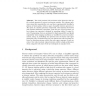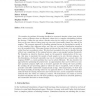310 search results - page 21 / 62 » MuFeSaC: Learning When to Use Which Feature Detector |
ICMLA
2010
13 years 7 months ago
2010
Abstract--Clinical electroencephalography (EEG) is routinely used to monitor brain function in critically ill patients, and specific EEG waveforms are recognized by clinicians as s...
ICRA
2010
IEEE
13 years 7 months ago
2010
IEEE
— Detecting the boundaries of objects is a key step in separating foreground objects from the background, which is useful for robotics and computer vision applications, such as o...
EVOW
2007
Springer
14 years 1 months ago
2007
Springer
Abstract. This work presents scale invariant region detectors that apply evolved operators to extract an interest measure. We evaluate operators using their repeatability rate, and...
JMLR
2008
13 years 9 months ago
2008
We consider the problem of learning classifiers in structured domains, where some objects have a subset of features that are inherently absent due to complex relationships between...
NN
2002
Springer
13 years 8 months ago
2002
Springer
This paper presents a biologically-inspired, hardware-realisable spiking neuron model, which we call the Temporal Noisy-Leaky Integrator (TNLI). The dynamic applications of the mo...


